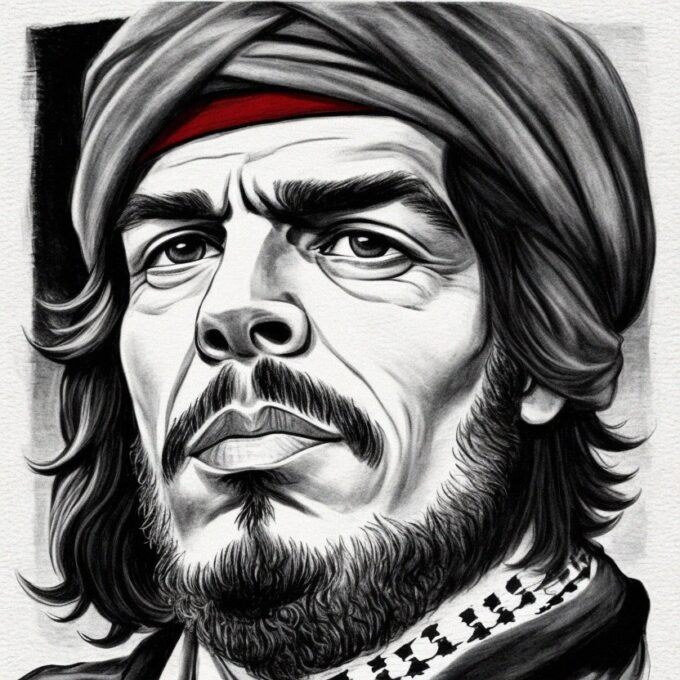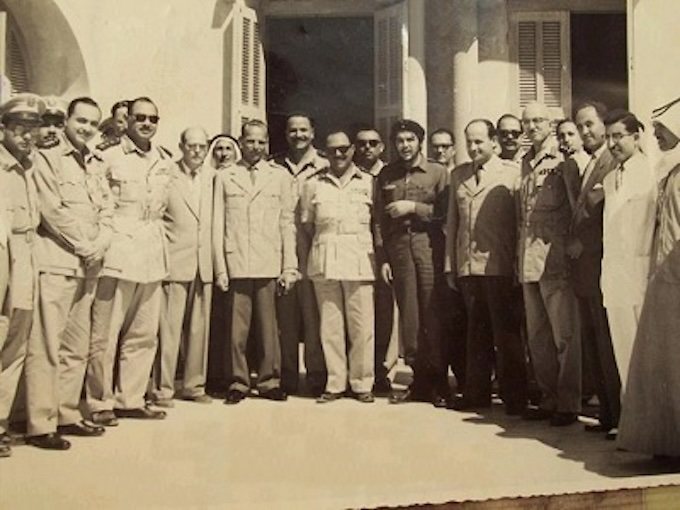

Che in Gaza. Image: JSC and AI Art Generator.
‘The Cuban delegation extends greetings to the peoples of Southern Rhodesia and South-West Africa, oppressed by white colonialist minorities; to the peoples of Basutoland, Bechuanaland, Swaziland, French Somaliland, the Arabs of Palestine, Aden and the Protectorates, Oman; and to all peoples in conflict with imperialism and colonialism. We reaffirm our support to them.’
– Che Guevara, address delivered to the 19th General Assembly of the United Nations, New York, December 11, 1964.
On 9 October 2023, the 56th anniversary of Ernesto “Che” Guevara’s death, escalation of violence began again across Israel and Palestine, after Hamas initiated a surprise military offensive. Israel’s military offensive on Gaza has been devastating. The coinciding of these events with the anniversary of Guevara’s assassination in Bolivia brings up once more the intertwining histories of Che Guevara and Palestine.
On June 18, 1959, Guevara visited the Gaza Strip, at the request of Egypt President Gamal Abdel Nasser. Egypt– then the United Arab Republic comprising Egypt, Syria, and Yemen (1958-1961– was the first leg of a ‘Goodwill Mission’ led by Guevara on behalf of the new Cuban government. The trip constituted the Cuban Revolution’s first overseas mission and led to the establishment and strengthening of ties between Cuba and Afro-Asia. Guevara secured new diplomatic and commercial relations for Cuba, as it pulled away from US political and economic domination. It was this trip that opened up a new relationship with Africa that has endured to this day, most notably involving substantial Cuban military support in the intervention in Angola as part of the struggle against South African apartheid.
Guevara and the Cuban delegation were taken first to a Palestinian village, which was inhabited by 120,000 Palestinian refugees of the 1948 Nakba. According to Omar Fernández Cañizares, a captain in the Cuban Rebel Army who undertook several important roles in the Revolution – and who accompanied Guevara on this trip– they witnessed miserable conditions. Observing the Palestinian displacement, Guevara remarked to Fernández, “Look, this is the work of the Gringos [United States].”[1] A refugee in Rafah approached Guevara and asked that the Cubans tell the Americas the truth of what they witnessed there. Guevara embraced the refugee and answered that Cuba would denounce what they had seen “before all of humanity.”[2]
Guevara’s presence in the Gaza Strip has been described as “momentous” by Palestinian researcher Salman Abu Sitta, who writes that this was the “first time a famous revolutionary came to see the devastation created by Al Nakba first hand.” [3] Despite this, Guevara’s visit was strangely underreported and remains somewhat unknown to this day. Scarcely any accounts, academic or otherwise, have documented this trip or attributed much significance to it. Guevara did not write about the visit in his report on visiting the UAR, his reflections on traveling across the “Afro-Asian Balcony,” or the two press conferences he gave following the Goodwill mission. And while Cuba and Palestine embarked on a shared history of solidarity, with the Cubans offering scholarships, citizenships, and material support, this did not happen until long after Guevara’s visit.

Guevara in Gaza. Photo: Salma Abu Sitta.
According to Abu Sitta’s conversations with contemporaries who witnessed Guevara’s visit, the Argentine wanted to supply arms and military training to the Palestinians, but Fidel Castro “wanted this aid to be coordinated through Nasser.”[4] He further states that Guevara questioned a Palestinian camp leader on what they were doing to liberate their nation: “Where are the training camps? Where are the factories to manufacture arms? Where are people’s mobilization centers?”[5]
According to Lena Meari, Guevara’s example, and the Cuban Revolution more broadly, were sources of inspiration for Palestinian resistance:
As a former PFLP leader told me in November 2017: The leftist Palestinian organizations emerged in a historical period characterized by the victory of the revolution in Cuba. As an emergent revolution, the Palestinian revolution needed ideological, material, and arms support. It needed the experience of revolutionary movements in order to be able to build its own specific experience. The Cuban revolutionary regime provided [to] these needs.[6]
At both the United Nations in 1964 and the Afro-Asian Conference in Algiers the following year, Guevara voiced support for the Palestinians. Indeed, in 1964, Cuba was one of the first nations to recognize the newly-founded Palestine Liberation Organisation. Although concrete information on Guevara’s visit to Gaza remains unclear, there is no doubt that he did use international forums, on behalf of the Cuban state, to support Palestine “before all of humanity.”
Indeed, the Cuban Government has a long-standing history of supporting Palestinians. In 1973, Cuba broke off relations with Israel, and Castro spoke out many times to defend Palestine, developing a close relationship with PLO leader Yaser Arafat.
There is a wider context of Guevara’s visit to Gaza, which coincided with a significant moment in the history of both the Cuban Revolution and the “Third World.” The 1959 Cuban Revolution constituted the “entrance of Latin America into the circuit of contemporary history.”[7] Between the Asian-African Conference at Bandung in 1955, and the founding of the Non-Aligned Movement in 1961 at Belgrade, the Cuban Revolution contributed to a widening, and radicalization, of the “Third World” political project. While colonization had ended much earlier in Latin America, the continent nonetheless had shared characteristics of underdevelopment, neo-colonialism, and structural economic dependence, just like the rest of the “Third World.” It was these common experiences that Guevara sought to highlight on his Goodwill mission; but further, Guevara strove for a new, tricontinental bloc of anti-imperialist countries.
The visit to Palestine is a significant, though often overlooked, event in the Cuban Revolution, whereby Cuba began to position itself as a voice for oppressed and underdeveloped nations and movements. This critical support for liberation movements would contribute to Cuba playing a leading part in the radicalization of the Third World project which took place between Bandung in 1955 and Belgrade in 1961. By the time of the founding of the 1961 Non-Aligned Movement, the ‘Third World’, or ‘neutralist’, movement had shifted from a largely moderate, passive, Nehruvian non-alignment, to an actively radical, outspoken political project. The Cuban Revolution both coincided with and contributed to this radicalization, as it brought Latin America into the fold, began to recognize liberation movements, and used international forums to denounce imperialism and establish relations with radical Afro-Asian movements.
In this sense, Guevara’s 1959 trip to Afro-Asia is a significant event in the radicalization of the Third World political project and in the consolidation of a radical, anti-imperialist bloc that culminated in the 1966 Tricontinental Conference in Havana. Bandung in 1955 had been a formal movement based rigidly on existing legal structures, and appealing to contemporary international law. By 1961, the Non-Aligned Movement had begun to blur the lines between sovereign nations and non-state actors and move from legalistic language to radical, outspoken rhetoric. The Algerian Front de libération nationale (FLN) and rebel Congolese government, for example, were invited as sovereign nations to the summit. Five years later, Havana hosted the Tricontinental Conference bringing together 500 delegates from 82 countries. The conference established the Organization of Solidarity with the People of Asia, Africa and Latin America (OSPAAAL), constituting the formal alliance of all three continents in opposition to imperialism and in support of global liberation movements. Palestine was represented at the Conference, and indeed the agreement of a Tricontinental meeting was agreed upon in Gaza, at a 1961 meeting hosted by the Palestine Committee for Afro-Asian Solidarity.[8]
Guevara’s visit to Gaza was brief, underreported, and remains a relatively underexplored event in the history of relations between Cuba and Palestine. Whatever extent Guevara’s visit contributed to making the defense of Palestine a global cause, there is no doubt that it happened at a significant moment in time for the Cuban Revolution and ‘Third World’ more broadly and that Cuban-Palestinian solidarity has endured well into the 21st Century. In 2014, for example, following an escalation of violence in the region, Cuba sent substantial medical assistance to Gaza.
Following the most recent events, the Cuban Government released a statement on 14 October calling for a ‘ceasefire and the immediate delivery of humanitarian assistance to Gaza’:
The Ministry of Foreign Affairs of the Republic of Cuba reiterates its deep concern about the escalation of violence between Israel and Palestine, which is a consequence of decades of Israeli illegal occupation and colonization practices, in flagrant violation of the inalienable rights of the Palestinian people in its own territory, as well as the long-lasting disregard of the Purposes and Principles of the United Nations Charter and International Law, including numerous relevant UN resolutions.
The statement further called for the ‘creation of an independent and sovereign Palestinian State based on the pre-1967 borders, with East Jerusalem as its capital, that would equally ensure the right of return of refugees’.
Guevara visited Gaza on behalf of the Cuban government in 1959, and, 64 years later, Cuba continues to voice support for Palestinians. Guevara’s ideas inspired revolutionary groups all over the world, including in Palestine, and the anniversary of his death coinciding with the latest act of resistance in Gaza is both an example of the long history of Israeli oppression and the continued intertwining of histories between Che Guevara and Palestine. More broadly, it is an interesting historical event with which to trace the long history of Cuban solidarity with Palestine.
I must say […] to all the hundreds of millions of Afro-Asians that … I am one brother more, one more among the multitudes of brothers in this part of the world that awaits with infinite anxiety the moment [when we can] consolidate the bloc that will destroy, once and for all, the anachronistic presence of colonial domination .[9]
Notes.
[1] Omar Fernández Cañizares, Un Viaje Histórico con el Che, La Habana: Ciencias Sociales, First edition ebook, 2014, 33.
[2] Cañizares, Un Viaje, 33.
[3] Salman Abu-Sitta, Che Guevara in Gaza: Palestine Becomes a Global Cause. Middle East Monitor, 2015, 5.
[4] Abu-Sitta, Che Guevara in Gaza, 7.
[5] Abu-Sitta, Che Guevara in Gaza, 7.
[6] Meari, Lena. Reading Che in Colonized Palestine. On analyzing and drawing inspiration from revolutionary Latin American texts. 2018. NACLA Report on the Americas. 52.
[7] Omar Fernández Cañizares, Primer Viaje del Che al Exterior, 50 aniversario, La Habana: Ciencias Sociales, 2010, 122.
[8] Oron, Yitzhak (ed.) (1961). Middle East Record, Vol 2. Tel Aviv: The Reuven Shiloah Research Center, Tel Aviv University.
[9] Guevara, Ernesto. Latin America as seen from the Afro-Asian Balcony. 1959. Humanismo.
The post Che Guevara and Gaza appeared first on CounterPunch.org.
This post was originally published on CounterPunch.org.